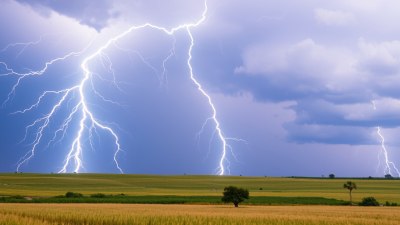Why Thunder Follows Lightning - Every Single Time
Understand why thunder always follows lightning with detailed scientific explanations and fascinating insights into storm phenomena.

Image created with Flux Schnell
Lightning and thunder are two of the most dramatic and awe-inspiring natural phenomena that occur during thunderstorms. Many people have observed that thunder always follows lightning, even though there might be a slight delay between the two. This article explores the scientific reasons why thunder follows lightning every single time, delving into the physics of storms, sound, and light, and offering a comprehensive understanding of this compelling natural process.
What Is Lightning?
Lightning is a powerful natural electrical discharge caused by the buildup of static electricity in clouds or between clouds and the ground. During a thunderstorm, collisions between particles such as ice crystals, water droplets, and hailstones create an electrical charge separation within the cloud, leading to the accumulation of positive and negative charges in different regions.
When the electrical potential difference becomes large enough, a rapid discharge of electricity occurs to neutralize the imbalance. This discharge is visible as a brilliant flash of light called lightning. The lightning bolt can travel within a cloud, between clouds, or from the cloud to the ground.
The Nature of Thunder
Thunder is the sound produced by the rapid expansion and contraction of air surrounding a lightning bolt. When lightning flashes, it heats the surrounding air to temperatures as high as 30,000 kelvins (53,540 degrees Fahrenheit) in a fraction of a second. This intense heat causes the air to expand explosively.
The sudden expansion generates shock waves that travel through the atmosphere as sound waves. These waves are heard as the rumbling or cracking sound of thunder. The length and intensity of thunder sounds can vary, depending on the type of lightning and the environment where it occurs.
Why Does Thunder Always Follow Lightning?
The key reason thunder always follows lightning lies in the different speeds at which light and sound travel through the atmosphere. Lightning produces both light and sound simultaneously, but we perceive these signals at different times because light travels much faster than sound.
Light travels through the Earth's atmosphere at approximately 299,792 kilometers per second (186,282 miles per second), essentially instant on a human scale. Conversely, sound travels at about 343 meters per second (1,235 kilometers per hour or 767 miles per hour) at sea level and at typical air temperatures.
When lightning strikes, the flash of light reaches our eyes almost instantaneously, regardless of distance. The thunder, however, takes longer to reach our ears because sound moves much slower through air. Thus, we observe the lightning first, followed by the thunder.
Distance and Thunder Delay
The delay between seeing lightning and hearing thunder can be used to estimate the distance between an observer and the lightning flash. Because sound travels roughly one mile in about five seconds (or one kilometer in roughly three seconds), counting the seconds between the flash and the rumble and dividing by five gives an approximate distance in miles, while dividing by three gives the distance in kilometers.
For example, if a person sees lightning and hears thunder 15 seconds later, the lightning strike was approximately three miles away. This method, sometimes called the "flash-to-bang" technique, is a practical way to gauge storm proximity.
Can Thunder Occur Without Visible Lightning?
Sometimes, people report hearing thunder without seeing lightning. This phenomenon, known as "heat lightning," occurs when lightning flashes from a distant storm are too far away for the light to be bright enough or the surroundings too dark for clear visibility. The sound of thunder usually does not carry as far as light due to atmospheric absorption and scattering, which explains why lightning can sometimes be seen without accompanying thunder.
The Physics of Lightning and Thunder
Lightning is essentially a giant spark of static electricity. Inside a thundercloud, frozen particles collide, causing electrons to be knocked loose and generating an electrical charge separation. The negatively charged bottom of the cloud induces a positive charge on the ground below.
The electric potential difference between the cloud and the ground can reach millions of volts. When it surpasses the insulating capacity of air, a conductive channel forms, called a stepped leader, which allows electrical current to flow. The connection to the ground leads to a return stroke, which is the bright flash seen as lightning.
This rapid movement of electric charge superheats the air, causing it to expand violently. The sudden increase in pressure generates a supersonic shock wave that transforms into an acoustic wave—the thunder we hear. The length and intensity of thunder reflect the path of the lightning channel.
Types of Lightning and Corresponding Thunder Sounds
There are several types of lightning, each producing thunder with distinctive characteristics:
- Cloud-to-Ground Lightning: When lightning strikes the ground, it often produces loud, sharp thunder due to the direct and intense heating near the surface.
- Intra-Cloud Lightning: Lightning inside a cloud may generate more muffled thunder sounds because the lightning channel is high and sound waves must travel through cloud moisture.
- Cloud-to-Cloud Lightning: Lightning jumping between clouds can produce varied thunder sounds, often softer and rolling, depending on distance.
- Sheet Lightning: This is when lightning occurs inside clouds and illuminates the sky like a bright sheet, usually producing distant, rolling thunder.
Environmental Factors Affecting Thunder
The characteristics of thunder can be influenced by environmental conditions such as temperature, humidity, terrain, and atmospheric pressure. Warmer air allows sound to travel faster, while humidity alters sound attenuation. Mountains and buildings can reflect and refract sound waves, causing echoes and variations in perceived thunder.
Additionally, thunder may seem louder or quieter depending on the observer's position relative to the lightning channel and terrain features. Atmospheric conditions can also affect how far thunder travel, sometimes muffling or enhancing its sound.
Lightning Safety and Thunder Awareness
Understanding that thunder follows lightning highlights the importance of lightning safety. The presence of thunder means lightning is close enough to pose a threat. The National Weather Service advises the "30-30 rule": if the time between lightning and thunder is 30 seconds or less, the storm is within six miles and dangerous. People should seek shelter indoors immediately.
Thunder serves as an auditory warning of electrical hazards outside. Lightning can cause injuries, fires, and even fatalities, so listening for thunder is critical for safety during storms.
Historical and Cultural Perspectives
Throughout history, lightning and thunder have fascinated and terrified people. They have been featured prominently in myths, legends, and religious beliefs. Ancient cultures often associated thunder and lightning with gods or supernatural forces—for example, Thor in Norse mythology wielded his hammer to generate thunder, while Zeus in Greek mythology controlled lightning bolts.
Modern science has demystified these phenomena, but thunder and lightning remain powerful symbols of nature's force and beauty. They continue to inspire art, literature, and scientific inquiry worldwide.
Technological Applications Inspired by Lightning and Thunder
The study of lightning and thunder has led to advances in technology and safety. Lightning rods, invented by Benjamin Franklin in the 18th century, protect structures by diverting lightning strikes safely to the ground. Modern meteorological instruments monitor lightning activity to forecast storms and provide warnings.
Research into the physics of lightning also aids in understanding electrical discharge processes, which have applications in fields like plasma physics, electrical engineering, and atmospheric science.
In summary, thunder follows lightning every time because they are simultaneous events conveyed through different media—light arriving nearly instantly, and sound lagging due to its slower speed. The delay between them depends on the distance of the lightning strike from the observer. The enormous heat generated by lightning causes explosive air expansion that creates thunder. Weather, geography, and atmospheric conditions influence how thunder sounds and how far it travels. Being attentive to thunder is essential for safety during storms.
Understanding these processes fosters a deeper appreciation of the dynamic and powerful natural events that shape our weather and environment.











